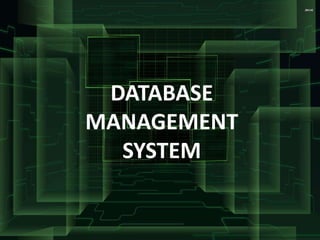
DATABASE MANAGEMENT SYSTEM.pptx
- 2. A database management system (DBMS) is system software for creating and managing databases. The DBMS provides users and programmers with a systematic way to create, retrieve, update and manage data.A DBMS makes it possible for end users to create, read, update and delete data in a database. The DBMS essentially serves as an interface between the database and end users or application programs, ensuring that data is consistently organized and remains easily accessible. The DBMS manages three important things: the data, the database engine that allows data to be accessed, locked and modified -- and the database schema, which defines the database’s logical structure. These three foundational elements help provide concurrency, security, data integrity and uniform administration procedures. Typical database administration tasks supported by the DBMS include change management, performance monitoring/tuning and backup and recovery. Many database management systems are also responsible for automated rollbacks, restarts and recovery as well as the logging and auditing of activity.. The DBMS is perhaps most useful for providing a centralized view of data that can be accessed by multiple users, from multiple locations, in a controlled manner. A DBMS can limit what data the end user sees, as well as how that end user can view the data, providing many views of a single database schema. End users and software programs are free from having to understand where the data is physically located or on what type of storage media it resides because the DBMS handles all requests. OVERVIEW
- 3. DBMS, developers won't have to modify programs just because changes have been made to the database. With relational DBMSs (RDBMSs), this API is SQL, a standard programming language for defining, protecting and accessing data in a RDBMS. Popular types of DBMSes Popular database models and their management systems include: Relational database management system (RDMS) - adaptable to most use cases, but RDBMS Tier-1 products can be quite expensive. 1)NoSQL DBMS - well-suited for loosely defined data structures that may evolve over time. In-memory database management system (IMDBMS) - provides faster response times and better performance. 2)Columnar database management system (CDBMS) - well-suited for data warehouses that have a large number of similar data items. Cloud-based data management system - the cloud service provider is responsible for providing and maintaining the DBMS.
- 4. Advantages of a DBMS Using a DBMS to store and manage data comes with advantages, but also overhead. One of the biggest advantages of using a DBMS is that it lets end users and application programmers access and use the same data while managing data integrity. Data is better protected and maintained when it can be shared using a DBMS instead of creating new iterations of the same data stored in new files for every new application. The DBMS provides a central store of data that can be accessed by multiple users in a controlled manner.Central storage and management of data within the DBMS provides: 1)Data abstraction and independence 2)Data security 3)A locking mechanism for concurrent access 4)An efficient handler to balance the needs of multiple applications using the same data 5)The ability to swiftly recover from crashes and errors, including restartability and recoverability DBMS Organization From a technical standpoint, database management systems can differ widely. The terms relational, networ flat, and hierarchical all refer to the way a DBMS organizes information internally. The internal organization affect how quickly and flexibly you can extract information lled SQL (structured query language). Sophisticated languages for managing database systems are called fou generation languages (or 4GLs for short).
- 5. DBMS Formats The information from a database can be presented in a variety of formats. Most DBMSs include a report writer program that enables you to output data in the form of a report. Many DBMSs also include a graphics component that enables you to output information in the form of graphs and charts. The DBMS can offer both logical and physical data independence. That means it can protect users and applications from needing to know where data is stored or having to be concerned about changes to the physical structure of data (storage and hardware). As long as programs use the application programming interface (API) for the database.